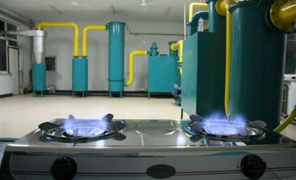在厭氧產(chǎn)生的沼氣罐不能立即使用,因為它包含大量的雜質(zhì)和有害物質(zhì),必須凈化,才能投入正常使用的管道,設(shè)備是更好的沼氣凈化和凈化的過程中嗎?
Biogas can not be used immediately because it contains a large number of impurities and harmful substances. It must be purified before it can be put into normal use. Is the equipment in the process of better biogas purification and purification?
在沼氣凈化的具體工藝設(shè)計中,首先要考慮項目的初期投資和后期的運營成本����,根據(jù)沼氣的流動范圍和工藝要求來確定具體的設(shè)備、工藝�。下面為大家介紹北京銀河瑞環(huán)境下的三種工藝方法,供大家參考�。
In the specific process design of biogas purification, the initial investment and later operation cost of the project shall be considered first, and the specific equipment and process shall be determined according to the flow range and process requirements of biogas. Here are three process methods under the environment of Beijing yinherui for your reference.
1. 變壓吸附。
1. PSA.
該方法采用活性炭分子篩���,能耗低�����,但甲烷損失較大�����。這種工藝方法需要預(yù)先脫硫��。
This method uses activated carbon molecular sieve, which has low energy consumption but large methane loss. This process requires pre desulfurization.
2. 化學吸收��。
2. Chemical absorption.
例如���,胺法�����,甲烷的損失可以很低����,高達0.1%�。但它需要大量的熱量和購買化學藥品,以及預(yù)先脫硫����。
For example, in the amine method, the loss of methane can be very low, up to 0.1%. But it requires a lot of heat and buying chemicals, as well as pre desulfurization.

3.高壓清洗����。
3. High pressure cleaning.
高壓清洗也有一個甲烷損失的問題�,好的制造商可以控制到1%甚至0.5%�。
High pressure cleaning also has a problem of methane loss. Good manufacturers can control it to 1% or even 0.5%.
人們常常認為高壓水清洗能耗高,事實上,沼氣凈化,凈化能源消耗主要發(fā)生在沼氣增壓階段,和沼氣的凈化需要增壓后,如果刪除這部分能源消耗,高壓水清洗能源消費不高。用于洗滌的水可以循環(huán)利用�����,實際用水量非常低�����。處理后的廢氣可用于蔬菜溫室����,為植物生長提供CO2。
People often think that the energy consumption of high-pressure water cleaning is high. In fact, the energy consumption of biogas purification and purification mainly occurs in the stage of biogas pressurization, and the purification of biogas needs pressurization. If this part of energy consumption is deleted, the energy consumption of high-pressure water cleaning is not high. The water used for washing can be recycled and the actual water consumption is very low. The treated waste gas can be used in vegetable greenhouse to provide CO2 for plant growth.
